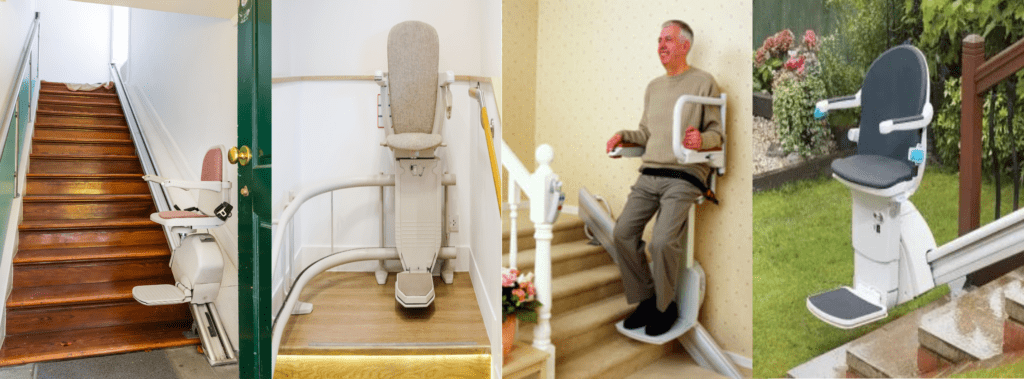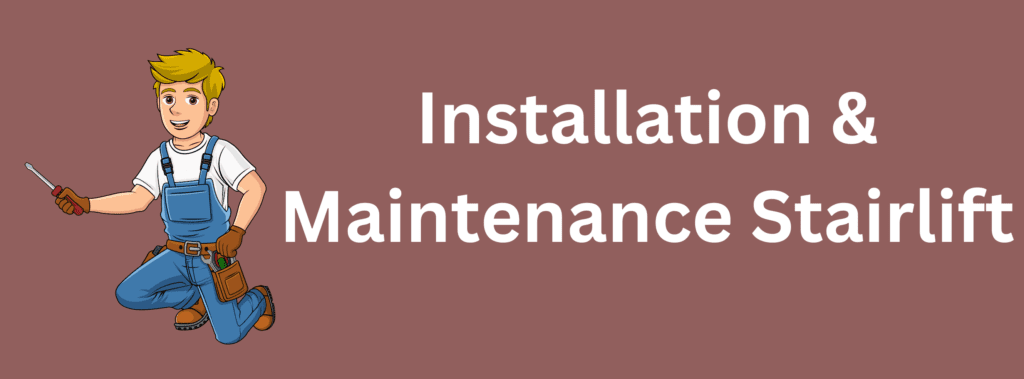Choosing the Right Stairlift: A Full Guide
Getting Up and Down Stairs Made Easier
For many disabled people and people who find it hard to move around, stairs can be a big issue. Stairlifts can help make life easier. A stairlift is a seat that moves up and down stairs on a track. It helps people go from one floor to another without walking up or down the stairs. This can make people independent and safe again in their homes.
Why Are Stairlifts Becoming More Popular?
Stairlifts are becoming more popular in Europe because more people want to stay in their homes as they get older.
The number of older adults is increasing, with the elderly population in Europe expected to reach around 191 million by 2050. Many of these older adults or people with mobility problems are choosing stairlifts to help them move safely between floors.
There are also more options for stairlifts now, with a range of prices to fit different budgets.
The stairlift market in Europe is growing quickly, and it is expected to increase by over 5% each year from 2023 to 2028. This growth is due to new designs, better technology, and more awareness about the benefits of stairlifts. These improvements make stairlifts safer, more comfortable, and easier to use.
Overall, stairlifts help people live in their homes for longer, making life easier and more enjoyable.
Why Choosing the Right Stairlift Matters
Picking the right stairlift for your home is very important. The right stairlift should:
- Be safe for you
- Feel comfortable to sit on
- Be easy to use.
This guide will show you what to think about when choosing a stairlift, so you can make the best choice for your home.

Stairlift Checklist
Use this checklist to help you choose the right stairlift for your needs:
How You Move:
- Do I have trouble with balance?
- Do I find it hard to stand or sit?
- Do I need extra support while using stairs?
Stair Shape:
- Are my stairs straight?
- Are my stairs curved or spiral?
- Are there sharp turns or multiple landings?
Space in the Home:
- Is there enough space at the top and bottom of the stairs?
- Do I need a stairlift that folds up to save space?
Money Matters:
- What is my budget?
- Can I get a grant or financial help?
- Are there payment plans or loans available?
Future Needs
- Can the stairlift be changed or upgraded if my needs change?
- Can I add features like a powered seat or footrest later?
- Will the stairlift track fit if I need a different stairlift model later?
- Does the stairlift come with a good warranty or service plan for repairs?
Go through each item on this checklist to understand what you need. This will help you find the best stairlift for your home.
Types of Stairlifts
| Type of Stairlift | Best For | Features | Cost |
| Straight Stairlifts | Homes with straight stairs without bends or landings. | Runs on a straight rail; quick to install. | £2,000 – £3,500 |
| Curved Stairlifts | Stairs with curves, corners, or multiple levels. | Custom-made to fit unique shapes; provides a smooth ride. | £4,000 – £8,000 |
| Outdoor Stairlifts | Outdoor stairs, such as those leading to a garden or front door. | Made from weatherproof materials; built to handle rain, snow, sun. | £3,000 – £6,000 |
| Standing and Perch Stairlifts | People who find it hard to sit or bend their knees; narrow stairs. | Small platform or perch to stand on; suitable for narrow stairs. | £2,500 – £5,000 |
Manufacturers design different stairlifts to meet varying needs and staircase configurations. Below are the main types to consider:
Straight Stairlifts
These are ideal for homes with straight staircases without bends or landings. The most common and usually the least expensive option is that they run on a straight rail that installers attach directly to the stairs. Installers can set them up quickly, and the costs range from £2,000 to £3,500, including installation.
Curved Stairlifts
Suitable for staircases with curves, corners, or multiple levels. These stairlifts are custom-made to fit your staircase’s unique shape, providing a smooth and comfortable ride. The bespoke design makes them more expensive, costing between £4,000 and £8,000.
Outdoor Stairlifts
These stairlifts are perfect for outdoor staircases, such as those leading to a garden or front door. They are made from durable, weatherproof materials and built to withstand various weather conditions, including rain, snow, and sun. Prices typically range from £3,000 to £6,000.
Standing and Perch Stairlifts
Designed for those who find it difficult to sit or bend their knees, these models offer a small platform or perch to stand on. They are ideal for narrow staircases where a seated option might not fit. Costs are similar to seated straight stairlifts, ranging from £2,500 to £5,000.
Key Features to Consider
When choosing a stairlift, it’s important to consider features that improve safety, comfort, and ease of use:
- Safety: You should prioritise stairlifts equipped with safety belts, obstruction sensors, and swivel seats, as these features make getting on and off the stairlift safer and more accessible.
- Ease of Use: Look for models with simple, intuitive controls. Many stairlifts include remote controls for added convenience.
- Comfort: Opt for stairlifts with padded seats and armrests. Adjustable seat heights can also improve comfort for different users.
- Power Source: Most stairlifts are battery-operated and have charging points at both the top and bottom of the stairs, ensuring they will continue to operate even during a power outage.
- Weight Capacity: Choose a stairlift that supports the user’s weight. Standard models usually support up to 20 stone (127 kg), while heavy-duty models are available for larger people.

Installation and Maintenance
Installation:
Always have a professional install your stairlift to guarantee safety and reliability. Here’s what you should know:
- Professional Assessment: A professional assessment of your home and specific needs is needed to determine the most suitable stairlift. Tailoring the stairlift to your needs and home layout can enhance its effectiveness and safety.
- Time: Straight stairlifts can often be installed in just a few hours, while curved models may take longer due to their custom design.
- Minimal Disruption: The installation process usually causes minimal disruption since installers mount the stairlift on the stairs, not the walls.
Maintenance:
Regular maintenance keeps your stairlift in good working order and ensures safety. We recommend servicing your stairlift annually to prevent breakdowns and ensure all safety features function properly.
- Servicing: Most manufacturers recommend annual servicing to prevent breakdowns and keep all safety features functioning properly.
- Warranties and Guarantees: Check if your stairlift has a warranty and what it covers. Many companies offer extended warranties that include routine maintenance and repairs.
Finding help to buy a stairlift
Stairlifts are a big investment in your lifestyle, but there is help to manage the costs.
Grants and Funding Options for Stairlifts in the UK
In the UK, several grants and funding options can help cover the cost of buying and installing stairlifts in homes. These options are mostly for people with disabilities or mobility problems who need changes at home to stay independent.
Disabled Facilities Grant (DFG)
The Disabled Facilities Grant (DFG) is a major source of money for home changes, including stairlifts. This grant is based on your income and savings and can pay for needed changes to make a home easier to live in. The amount of money you can get depends on where you live:
- Up to £30,000 in England
- Up to £25,000 in Northern Ireland
- Up to £36,000 in Wales
To apply for a DFG, contact your local council. This grant is usually available to homeowners, private tenants, and landlords who have tenants with disabilities. For more details, visit the Government’s website on DFG or Disability Rights UK.
Charitable Organisations
Some charities offer grants to help with buying stairlifts or other mobility aids. These charities often help people with certain disabilities or in specific groups. Here are a few:
- Independence at Home: Offers grants up to £2,000 for stairlifts. Applications must be made through a health or social care professional. More information is available at Age UK Mobility.
- The Edward Gostling Foundation: Provides money for those who need home adaptations.
- Charities which help retirees or ex-members of your profession: SSAFA and The Royal Agricultural Benevolent Institution provide support to specific groups, such as ex-forces personnel and those working in agriculture. Many other charities also offer assistance to people who have retired from specific professions, such as the Royal College of Nursing Foundation, which helps retired nurses.
Other Financial Help
- Local Community Trusts and Foundations: Some local trusts give grants for home changes, like stairlifts. These are often for specific areas, so check with local council offices or community centres for details.
- Insurance Coverage: Sometimes, health or home insurance may cover part of the cost for a stairlift, depending on your policy and health condition.
- Loans and Financing Options: Many stairlift companies offer payment plans, which allow you to pay in smaller amounts over time. This can make the cost easier to handle.
- Renting: If you only need a stairlift for a short period, consider renting one. Rental agreements often include installation, maintenance, and servicing.
- Reconditioned Stairlifts: Buying a reconditioned stairlift is a cost-effective alternative. Manufacturers refurbish these used stairlifts to meet current safety standards.
Glossary of Terms
Like most industries you will find some “jargon”! We’ve included a glossary below of the most obscure terms:
- Bespoke Design: A custom-made design that fits the exact shape of a staircase, often used for curved stairlifts.
- Obstruction Sensors: Safety features that detect things on the stairs and stop the stairlift to prevent accidents.
- Swivel Seat: A seat that turns to help the user get on and off the stairlift more safely and easily.
- Perch Stairlift: A type of stairlift for people who find it hard to sit or bend their knees. It has a small platform or perch to stand on.
- Heavy-Duty Models: Stairlifts made to support users with higher weight needs, usually above 20 stone (127 kg).
- Reconditioned Stairlifts: Used stairlifts that have been fixed and updated to meet safety standards, providing a cheaper option.
- Disabled Facilities Grant (DFG): Money from the UK government to help pay for home changes, like stairlifts, for people with disabilities.
- Bariatric Stairlift: A stairlift for users who are obese/overweight. It has a wider seat and a higher weight limit.
- Incline Limit: The steepest angle a stairlift can safely go up or down, usually around 45 degrees.
- Soft Start/Soft Stop: A feature that makes sure the stairlift starts and stops smoothly, reducing sudden movements and making it more comfortable.
Choosing the right stairlift is a crucial decision that can significantly impact the quality of life for disabled people. By understanding your needs, exploring your options, and considering key features, you can find a stairlift that provides comfort, safety, and independence. Always seek professional advice to ensure you make the best choice for your specific circumstances.


